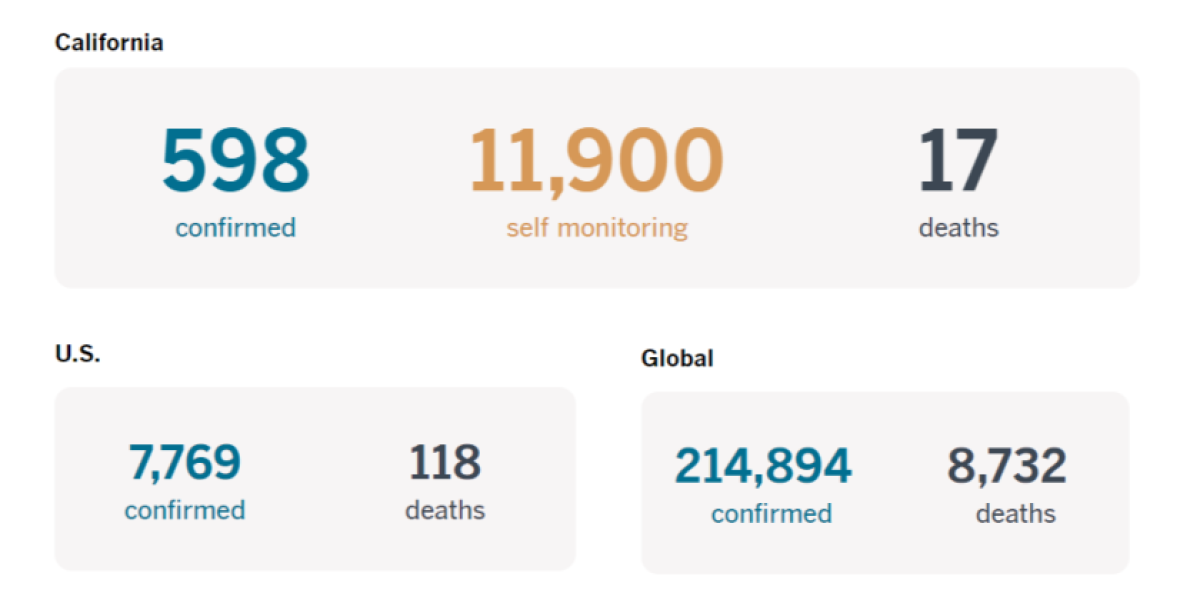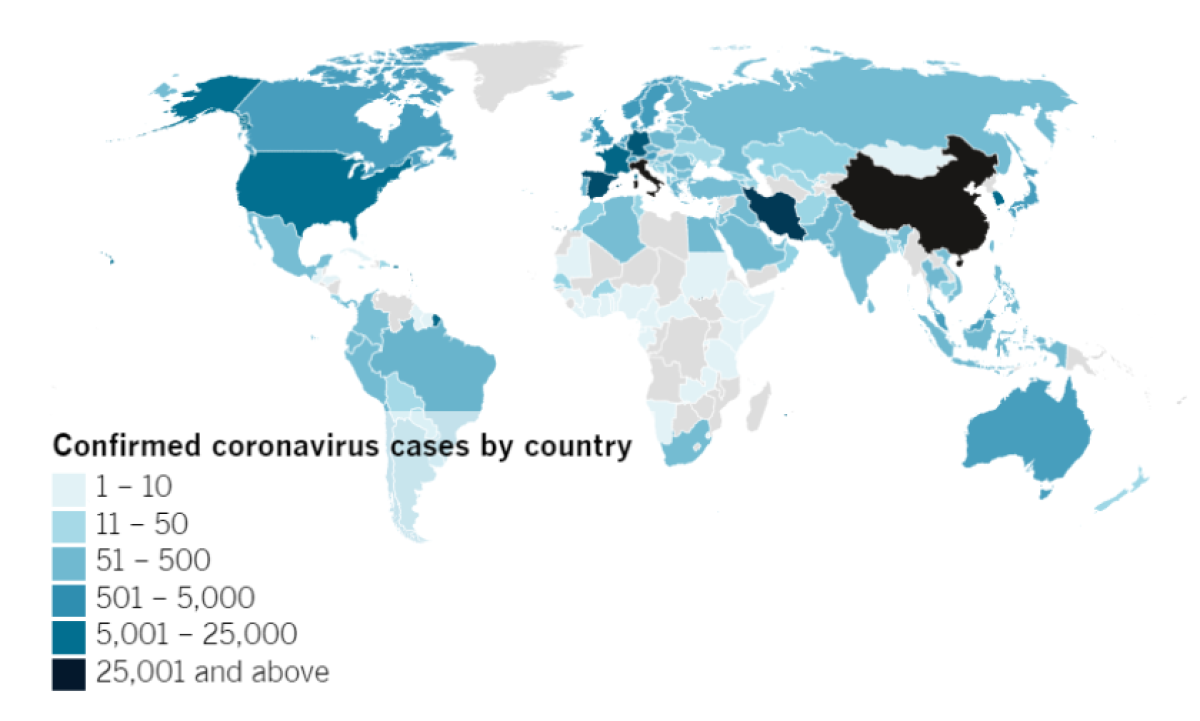Coronavirus Today: A marathon, not a sprint
Good evening. I’m Diya Chacko, and it’s Wednesday, March 18. Here’s what’s happening with the coronavirus outbreak in California and beyond.
As we end day two of mass lockdown orders, the realization is slowly dawning for many Californians: Fighting this outbreak will be a marathon, not a sprint.
At least 16 counties, most of them in the Bay Area, and the city of Palm Springs have directed all residents to stay at home as much as possible, meaning more than 9 million Californians are under orders to shelter in place. So far, none of those orders has come from Gov. Gavin Newsom; they’ve been left up to counties and cities to put into effect.
Some have questioned Newsom’s softer approach in contrast to those of governors who have issued sweeping statewide orders. Others, however, see him attempting methodically to ease Californians into a new way of life. The state is “settling in to the unimaginable,” as Essential California writer Julia Wick put it in this morning’s newsletter.
On the eve of the first day of spring, California State Parks has closed all campgrounds. The good news: Hiking trails and beaches are still open, and for now, you can still go hiking as long as you practice social distancing and steer clear of others.
Even at public health-approved distances, Californians are finding creative ways to take care of each other for things as ordinary as celebrating birthdays. Here’s one example: When the outbreak canceled Jack Henry’s 7th birthday party, his mother took him for a walk in their Culver City neighborhood. As a surprise, residents around the block posted homemade signs in their windows that proclaimed “Happy Birthday Jack Henry” in bright crayon and marker.
President Trump invoked wartime powers to boost manufacturing of medical equipment needed to fight the pandemic and signed a measure to provide paid sick leave and free coronavirus testing to all Americans, hours after the Senate passed it. Trump administration officials are increasingly stressing their eagerness to extend health protections to more Americans, in sharp contrast with their healthcare agenda prior to the outbreak. “Coronavirus simply makes more palpable and immediate the ramifications of opposition to coverage expansion,” one public health expert said.
The pandemic is also testing another cornerstone of Trump’s agenda: the U.S. immigration system. In packed courtrooms and overcrowded detention centers, social distancing measures are almost impossible to implement. “It’s a tinderbox,” said one law professor. Immigration and Customs Enforcement, facing criticism from across the country for continued enforcement actions amid the pandemic, will reduce arrests and shift its focus to “public safety risks.”
By the numbers
Cases as of 5:30 p.m. PT Wednesday:

Track the latest numbers and how they break down by county and by state with our graphics.
Where is the coronavirus spreading?

Your support helps us deliver the news that matters most.
Across California
As hospitals and clinics face shortages of safety equipment and devices needed to treat patients, a Times data analysis found that California has roughly one intensive-care bed for every 5,500 residents. Experts said that capacity could easily be reached soon if the virus’ spread continues unabated. Another possible shortage also looms: Because of virus-related delays in processing H2-A visas in Mexico, California’s agricultural industry is bracing for a potential labor shortfall that could hinder efforts to maintain the nation’s fresh food supply.
With about 108,000 Californians living on the street, homeless encampments present a significant problem for containing the spread of COVID-19. On Wednesday, Newsom announced $150 million in emergency funding to move homeless people indoors quickly, and L.A. Mayor Eric Garcetti announced plans to convert 42 of its recreation centers into temporary shelters for homeless residents.
As much of the rest of Los Angeles hunkers down at home, food vendors and sidewalk sellers are struggling to get by with dwindling crowds and meager sales. Vendors who made hundreds of dollars a week are now only making enough to cover their expenses. The timing of the pandemic could also pose major revenue problems for scooter companies, which see business fall off in the winter and pick up again when the weather gets nicer. Lime is pulling its shared electric scooters from 20 countries and 21 states, including California.
Since Utah Jazz center Rudy Gobert tested positive March 11, a handful of NBA teams, including the Lakers, have offered coronavirus testing for their players, whether they have symptoms or not. Most teams paid for the tests to be administered and analyzed at private facilities, raising questions around whether the wealthy are getting preferential treatment amid a nationwide shortage of test kits.
How to stay safe
— Wash your hands for at least 20 seconds! Here’s a super fun how-to video.
— Stop touching your face, and keep your phone clean.
— Watch for these symptoms of possible infection: fever, cough, shortness of breath.
— Help yourself and others by practicing social distancing. If you absolutely must be out in public, maintain a six-foot radius of personal space.
— If you’re sick, stay home. If you’re worried you might be infected, call your doctor or urgent care clinic.
How to stay sane
— Wondering whether you should self-quarantine? Here’s our guide.
— Need groceries? Here’s how to stock up for a self-quarantine. You can also watch our video guide on YouTube.
— Visit our free games and puzzles page for daily crosswords, card games, arcade games and more.
Around the nation and the world
An estimated 3,000 Americans are stranded overseas and desperately trying to get on rescue flights back home, with complaints of inaction on the part of the U.S. government. According to one group of travelers stuck in Morocco, U.S. authorities have done little more than direct citizens to book seats on those rescue flights, or prepare to hunker down in place.
Staff members at the Seattle-area nursing home associated with 35 deaths due to COVID-19 spread the coronavirus to other facilities where they worked, according to an investigation led by the Centers for Disease Control and Prevention.
Faced with criticism after insisting that preparations for the 2020 Summer Games in Tokyo should proceed, the International Olympic Committee walked its comments back Wednesday. Leaders have spent this week consulting with national Olympic committees and the international federations that govern each sport.
The U.S. Census Bureau is temporarily suspending all field operations for the 2020 census until April 1. But the inability to knock on doors is hurting grassroots groups looking to amp up participation in historically hard-to-count communities.
Drive-in movie theaters might seem an anachronistic diversion. But with theaters implementing social distancing measures, several of the country’s 305 drive-ins are experiencing a surge in interest. “Nobody is near us, and we can actually enjoy the movie without feeling that paranoia where something like somebody coughing would have us instantly move,” one movie-goer said.
With production on their late-night programs shut down, hosts Jimmy Fallon, Jimmy Kimmel, Trevor Noah, Stephen Colbert and Conan O’Brien all filmed material from the safety of their homes. “Get comfortable,” said Colbert, addressing viewers from a bubble-filled bathtub. “Try to look on the bright side: You’re finally going to get a chance to binge-watch all that toilet paper you bought. And you better watch it, Jack. Because I am coming for it.”
Your questions answered
Today’s reader question comes from Gregory Bailey, who wants to know: Will COVID-19 subside when spring arrives? Here are some answers from graphics reporter Paul Duginski:
It is true that in the springtime, flu viruses and other types of coronaviruses that cause common colds often fade, according to Dr. Anthony Fauci, director of the National Institute of Allergy and Infectious Diseases. But because this coronavirus is brand new, no one really knows what will happen.
The World Health Organization noted that the coronavirus has infected people on every continent except Antarctica. It can be transmitted in all areas of the globe, including those with hot and humid weather.
Another infectious disease expert said it’s a myth that warmer weather brought an end to the 2003 SARS outbreak. In fact, “it was killed by extremely intense public health interventions,” such as isolating infected people and quarantining those who came in contact with them.
Got a question? Our reporters covering the coronavirus outbreak want to hear from you. Email us your questions, and we’ll do our best to answer them. You can find answers to other common questions in our morning and midday roundup.
For the most up-to-date coronavirus coverage from The Times, visit our live updates page, visit our Health section and follow us on Twitter and on Instagram.




